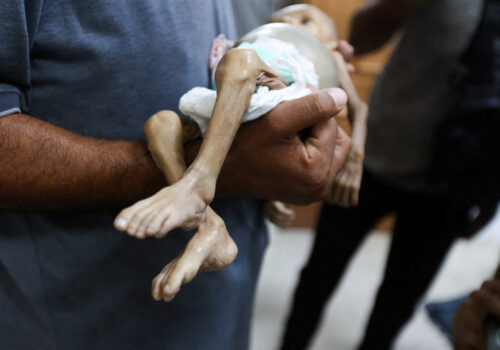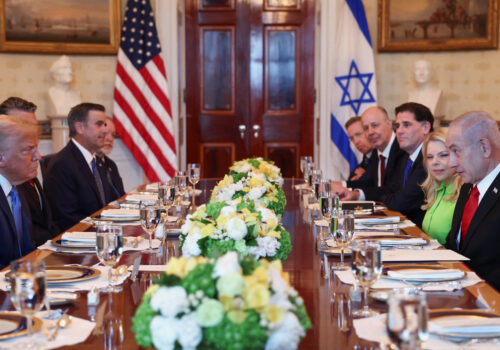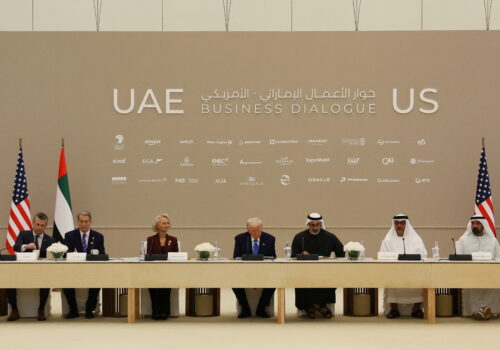Why Gaza’s post-Hamas future depends on its Arab neighbors—not just Israel
Israel’s ongoing war in Gaza has ignited important discourse over potential governance solutions for the post-Hamas era. Several options and models have been proposed for Gaza’s future, but as long as Hamas continues to exist—whether as an armed group, a political movement, or even just an idea—there remains a significant risk that it could reassert influence over the Gaza Strip to advance its own interests. Key factors such as whether Hamas agrees to disarm, who will govern Gaza, the potential presence of Israeli forces, and the impact of the war with Iran on Hamas’s ability to rebuild, among others, will undoubtedly have a significant effect on the outcome.
But in any “day after” scenario with respect to the Israel-Gaza war, it will be extremely difficult to completely prevent Hamas from operating within the Palestinian enclave, because Hamas is not just an armed terrorist organization—it is an idea rooted in ideology: the belief that a Palestinian state should stretch from the Jordan River to the Mediterranean Sea, without recognizing the existence of Israel. Over almost two years of war, Hamas has demonstrated that—despite facing criticism from the population in Gaza for the devastation it has caused and their desire to end the conflict—it remains unwilling to accept a cease-fire that compromises its own interests, particularly its ability to continue ruling in a post-war Gaza. This shows that the militant group is prepared to make significant sacrifices for its own survival and influence, even at the expense of the Palestinian population.
Moving forward, the most crucial step in minimizing Hamas’s power and influence is to ensure it is no longer responsible for the welfare of Gaza’s population.
SIGN UP FOR THIS WEEK IN THE MIDEAST NEWSLETTER
This requires the establishment of a strong civil alternative to Hamas—whether in the form of a new, functional governing mechanism or a government—that can meet the needs of the population and maintain local legitimacy and authority capable of restoring and rehabilitating civilian life in Gaza. Importantly, this alternative must not be seen as an enemy or as part of the problem, but rather as part of the solution. The international community—particularly neighboring Arab states—must recognize this alternative and be willing to support and fund it as it seeks to rebuild Gaza and manage its day-to-day affairs in the aftermath of the war.
For this reason, Israel cannot be the provider of the civil solution in the post-Hamas period. It would be difficult for Israel to gain the trust of Gaza’s local population and the international community. It would likely hinder access to international funding, as the international community is likely to support—both ideologically and financially—a local, or at least Arab-led, solution for Gaza and the broader Palestinian issue.
The prevailing civil authority
The possibility of Hamas remaining a political party in Gaza presents many challenges: for Israel, for the West, and for the people in Gaza, who have suffered severely after Hamas’s October 7, 2023, attack on Israel and the ensuing war. The war in Gaza has killed over fifty thousand, according to local Hamas authorities, and has caused severe destruction of civilian infrastructure, mass displacement, and critical shortages of food and necessities.
Before October 7, Hamas’s de facto government in Gaza provided a wide range of civil and social services through both its formal governance structures and its “Da’wa system”—or Hamas’s network of social, educational, and religious institutions that provide services, promote its ideology, and build grassroots support among the Palestinian population. These services included policing and internal security, civil registry and municipal functions, courts and legal institutions, healthcare, education, social welfare, religious affairs, and, to a limited extent, infrastructure and utilities. One main goal is to prevent Hamas from continuing to rule Gaza and to allow the alternative government to provide those services.
Today, Hamas, as the Gaza Strip’s prevailing civil authority, still maintains its dominance by being one of the few viable ways for Palestinians in Gaza to earn a living, especially since the escalation of war with Israel and its destruction in Gaza. That includes individuals who would not otherwise support the organization or adhere to its radical ideology. In addition, Hamas remains armed, instills fear, and actively suppresses dissent. As long as this remains the reality on the ground, meaningful change is unlikely.
For this reason, foreign intervention in ousting the group from power appears to be necessary.
Any such initiative for an alternative—whether a temporary administrative framework or a transitional government—must be led by a major Arab power in coordination with representatives of the Gaza population. For example, a new Arab government unconnected to Hamas, led by a prime minister backed by the Gulf states and the United States, could receive Gulf funding to rebuild Gaza and provide essential civilian services such as healthcare, education, and more.
Moreover, donor countries must ensure that reconstruction funds are used exclusively for civilian needs. This includes severing Hamas’s ties to the population by placing foreign oversight over humanitarian aid, food distribution, and border crossings.
In a scenario where the war in Gaza ends and a political solution establishes a different sovereign authority in the region, Hamas would likely seek to remain relevant to the people of the Gaza Strip—as both a political and armed force opposing Israel, and as a dominant player in daily life—if not through ruling Gaza, then through its Da’wa system.
For an alternative government in Gaza to be effective, it must have an independent and vested interest in preventing Hamas from regaining control. One such alternative could be Fatah, a political rival of Hamas, with whom there has been a longstanding struggle over Palestinian leadership. The conflict between the two worsened after Hamas took control of the Gaza Strip from Fatah in 2007, during which many Fatah officials were imprisoned, executed, or expelled. However, Fatah alone may not be strong enough to dismantle Hamas’s influence or to fully restore civilian life in the Gaza Strip.
Cutting the ties of Hamas’s financial network
With this context in mind, removing Hamas from its authority over the strip will require weakening its financial, and not just its military, network. This will also help to prevent it from paying the salaries that help to maintain its grip on Gaza.
To achieve this, Israel and other relevant countries involved in Gaza’s post-war rehabilitation must halt financial transfers to Hamas—especially those from Iran and Qatar, which are its primary sources of state-sponsored external funding.
This also includes crackdowns on individuals working within the organization, financial entities, or individuals who fund it, and money changers who facilitate the transfer of funds into Gaza for Hamas. This could help reduce the incentive to receive salaries or services from Hamas, support its activities, or collaborate with it.
More importantly, such measures could also assist in curbing the spread of Hamas’s Da’wa system, particularly within the education system, which Hamas largely controlled before the war. However, such sanctions cannot rely solely on foreign enforcement or the inclusion of Hamas figures and institutions on international sanctions lists. Instead, they must also be implemented by the civil authority governing the Gaza Strip. This entity must have both the legitimacy and the capacity to enforce these measures, supported by international actors involved in Gaza’s rehabilitation.
Enduring threat of military capabilities
While establishing a viable alternative to Hamas—at least in terms of providing basic services to the people of Gaza—it is also essential to contain Hamas’s remaining military capabilities. Hamas currently refuses to fully disarm. In May, US Special Envoy Steve Witkoff described the militant group’s proposal for a hostage and cease-fire deal in Gaza as “totally unacceptable,” over Hamas’s demand that the war in Gaza end without agreeing to disarm, terms that Israel is unwilling to accept.
In such a scenario where Hamas retains military capabilities, even if officially removed from prevailing authority inside the strip, it becomes even more critical to bolster a strong governing mechanism in Gaza. This would require a civilian authority equipped not only with legitimacy and resources, but also with policing powers and a functioning legal system capable of using force if necessary. That said, this solution cannot be implemented unless Hamas’s military capabilities are severely degraded—ideally reaching a “tipping point” at which a well-trained, well-equipped, and legitimate civilian force can effectively manage any residual threat. At least for now—despite having lost much of its leadership, control over the entry of aid into Gaza, and other elements of governance—Hamas still retains functioning and effective military forces.
The future of Gaza after the war
Establishing a credible and durable alternative to Hamas means creating a political solution for the day after in Gaza. This alternative governing authority must have the backing of both Western and Gulf countries, along with the necessary resources and support to govern Gaza effectively.
For this effort to succeed, it is equally essential to weaken Hamas’s remaining capabilities—including its military strength, sources of funding, and control over civilian services.
From a broader perspective, as the Middle East undergoes significant changes, there may be an opportunity to include Gaza in a larger regional peace-building, potentially through cooperation with countries like Egypt—which shares a border with Gaza and has long served as a mediator between Israel and Hamas—or Saudi Arabia and the United Arab Emirates, which share mutual interests in preserving regional stability and investing in efforts to improve the living conditions of the population.
There is now potential for a significant regional change that renders Hamas unnecessary in the eyes of the public. With possible normalization agreements and new alliances emerging, there may soon be an opportunity to stabilize Gaza, improve the welfare of the population in the region, boost the economy, and create employment opportunities.
Maayan Dagan is a visiting research fellow at the Atlantic Council’s Middle East Programs, from the Israeli military. The views in this article are the author’s own and do not necessarily reflect those of any other entity.
Further reading
Tue, Jul 29, 2025
‘I can barely stand or make it through the day’: First-hand views of Gaza’s starvation
MENASource By Arwa Damon
Israel has systematically denied aid entry into Gaza, and perpetuated false narratives intended to discredit the humanitarian community.
Sat, Jul 12, 2025
Netanyahu’s trip to Washington ends with conflicting signals
MENASource By Daniel B. Shapiro
The moment of truth may yet come when Trump’s leverage on Netanyahu, which is considerable, may not be expressed only in private settings.
Wed, Jul 9, 2025
For the Gulf, business comes first—even after the Twelve Day War
MENASource By Joze Pelayo
Gulf leaders' desire to shift the regional narrative toward economic and technological development continues to be hijacked by conflict.
Image: The sun sets over north Gaza, July 28, 2025. REUTERS/Amir Cohen



